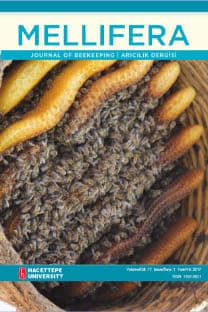Ege Bölgesi koşullarında ana arı (Apis mellifera L.) yetiştirme mevsiminin ana arı niteliklerine etkileri
Bu çalışma Ege Bölgesi koşullarında yetiştirme mevsiminin ana arının niteliklerine etkisini belirlemek amacıyla yapılmıştır. Araştırmada, 2000 yılının Mart ayından başlayarak Eylül ayına kadar 8 dönemde ana arı yetiştirilmiştir. Ana arının niteliğini belirleyen kriterlerden yüksük uzunluğu, yüksük hacmi, çıkış ağırlığı, yumurtlama öncesi süre, sperma kesesi çapı ve hacmi, sperm sayısı ve her dönem aşılama randımanı ve çiftleşme oranları belirlenmiştir. Sperma kesesi çapı ve hacmi üzerine yetiştirme mevsiminin etkisi önemsiz bulunmasına karşın aşılama randımanı ve çiftleşme oranları (P
Effects of rearing season on the quality of queen honeybees (Apis mellifera L.) raised under the conditions of Aegean Region
This study was conducted to determine the effects of rearing season on the quality of queen honeybees under the conditions of Aegean Region. The queen honeybees were raised in eight different periods from March through September 2000. Criteria for queen bee quality including acceptance rate of the grafted larvae, the length and volume of the queen cells, queen weight at emergence, pre-oviposition period, mating success of queens, the diameter and volume of spermatheca after mating, and the number of spermatozoa in spermatheca were determined f or each period. The length and volume of queen cells, pre-oviposition period of queens, queen weight at emergence and the numbers of spermatozoa in the spermatheca were affected by rearing season (P
___
- 1. Adam, B., Breeding the honeybee, Northern bee books, Mytholmyroyd: Hebden Bridge, West Yorkshire, U.K. 1987.
- 2. Ruttner, F., Breeding techniques and selection for breeding of the honeybee, Derby, UK, British Isles Bee Breeders' Association, 152 pp., 1988.
- 3. Gençer, H.V., Fıratlı, Ç., Bir ve iki gün yaşlı larvalardan yetiştirilen ana arıların (A.m. anatolica) bazı iç ve dış yapısal özelliklerinin karşılaştırılması, Tarım Bilimleri Dergisi, 5 (3): 13-16,1999.
- 4. Karacaoğlu, M.,Fıratlı, Ç., Bazı Anadolu bal arısı ekotipleri (Apis mellifera Anatoliaca ) ve melezlerinin özellikleri, II. koloni gelişimi ve üretimi, TUBITAK-Turkish Journal of Veterinary and Animal Science, 23 (1): 7-14, 1999.
- 5. Güler, A., Bek, Y., Forewing angles of honeybee (Apis mellifera L.) samples from different regions of Turkey, Journal of Apicultural Research, 40 (1-2): 43-49,2002.
- 6. Smith, D., Genetic diversity in Turkish honeybees, Uludağ Bee Journal, 2 (3): 10-17,2002.
- 7. Fıratlı, Ç., Budak, E., Ülkemizde çeşitli kurumlarca yetiştirilen ana arılar ile oluşturulan kolonilerin fizyolojik, morfolojik ve davranışsal farklılıklarının araştırılması, AUZF. No: 1390, Bilimsel Araştırmalar ve İncelemeler, 771, 1994.
- 8. Johanson, T.S.K., Johanson, M.P., Methods for rearing queens, Bee World, 54 (4): 149-175, 1973.
- 9. Taber, S., Poole, H. K., Rearing and mating of queen and drone honeybee in winter, American Bee Journal, 114 : (18-19), 1974.
- 10. Zhadanova, T.S., Influence of nest temperature on quality of queens produced artificially, XXI. Int. Apicultural Congre, Romania, 245-249, 1967.
- 11. Abdellatif, M.A., El-Gaiar, F.H., Mohana, N.F., Untersuchungen zur Koniginnenzucht und-paarung, Apiacta, 5(4): 9-10,1970.
- 12. Kaftanoglu, O., Kumova, U., Çukurova Bölgesi koşullarında ana an (Apis mellifera L.) yetiştirme mevsiminin ana arının kalitesine olan etkileri üzerine bir araştırma, TÜBİTAK, Doga-Tr., Journal of Veterinary and Animal Sciences, (16): 569-577, 1992.
- 13. Hasting, J.E., Production of quality queens, Gleaning in Bee Culture, 95(4):212-219, 1967.
- 14. Laidlaw, H.H.J.R., Contemporary queen rearing, Dadant and Sons Hamilton, Illinois, USA, 199p, 1979.
- 15. Mackensen, O., Tucker, K.W., Instrumental insemination of queen bees, Agriculture Handbook, No: 390, ARS, USDA. 1970.
- 16. Kaftanoglu, O., Düzenli, A., Kumova, U., Effect of the rearing season and flora on the quality of the queen honeybees (Apis mellifera L.) XXXIII. Int. Apic. Cong, of Apimondia, China, Sep 20th- 26th, 1993.
- 17. Güler, A., Korkmaz, A., Kaftanoglu, O., Reproductive characteristics of Turkish honeybee (Apis mellifera L.) Genotypes, Hayvansal Üretim Dergisi, 39-40: 113-119, 1999.
- 18. Dodaloğlu, A., Genç, F., Yetiştirme ve tohumlama yöntemlerinin ana arıların (Apis mellifera L.) bazı özelliklerine etkileri, Turkish Journal of Veterinary and Animal Sciences, 21:379-385, 1997.
- 19. Gençer, H. V., Shah, S. Q., Fıratlı, Ç., Effect of supplemental feeding of queen rearing colonies and larval age on the acceptance of grafted larvae and queen traits, Pakistan Journal of Biological Sciences, 3 (8): 1319-1322, 2000.
- 20. Woyke, J., Correlation between the ages at which honeybee brood was grafted characteristics of resultant queen and of insemination, Journal of Apicultural Research, 10 (1): 45-55, 1971.
- ISSN: 1302-5821
- Yayın Aralığı: 3
- Başlangıç: 2001
- Yayıncı: Hacettepe Üniversitesi
